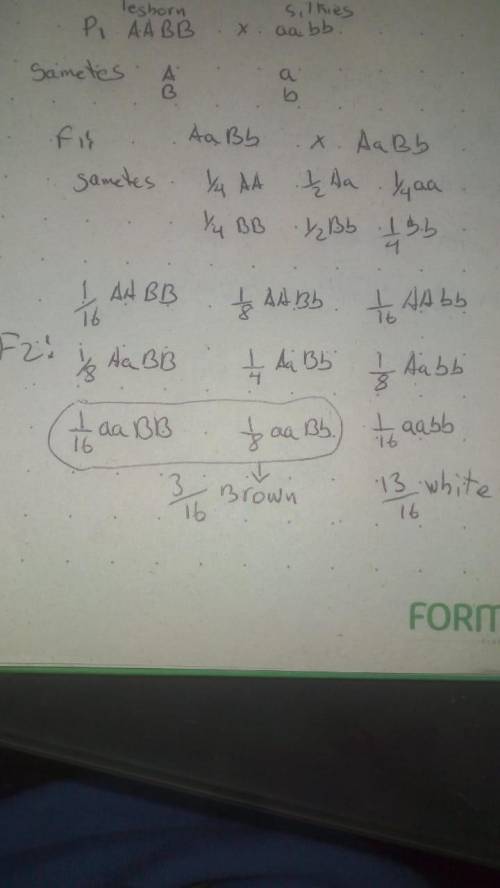
Biology, 04.10.2019 20:20 maddiefoley17
Abreed of chickens called silkies has white feathers due to a recessive allele. leghorns have white feathers due to a dominant allele in a second (different) gene. if true-breeding chickens of both breeds are crossed to each other, what is the expected phenotype of the f1 generation? if members of the f1 generation are mated to each other, what is the expected phenotypic outcome of the f2 generation? assume that the chickens in the parental generation are homozygous for the white allele at one gene and homozygous for the brown allele at the other gene. in subsequent generations, nonwhite birds will be brown.

Answers: 2


Another question on Biology

Biology, 22.06.2019 05:30
Plants consume most of their carbon from a. the soil b. the water c. the roots d. the air
Answers: 2

Biology, 22.06.2019 05:40
Benito is doing research on the effects of florida's elevation on its climate. his notes include the following: 1. the average elevation of florida is 30 m above sea level. 2. the highest point in florida is britton hill, which is 105 m above sea level. 3. the change in temperature from 0 m to 1,000 m is 7 °c. what can benito conclude about the effects of florida's elevation on its climate? a.) florida typically experiences cold temperatures and temperature changes within a narrow range. b.) florida typically experiences cold temperatures and temperature changes within a broad range. c.) florida typically experiences warm temperatures and temperature changes within a narrow range. d.) florida typically experiences warm temperatures and temperature changes within a broad range.
Answers: 1

Biology, 22.06.2019 16:30
Tay-sachs disease is caused by a mutation in the hexa gene located on chromosome 15. tay-sachs follows an autosomal recessive pattern of inheritance. with the of the diagram, identify which of the offspring will be an unaffected carrier. a diagram showing the genes of parents who are carriers of tay-sachs disease a. a, b, and c b. b and c c. a and d d. a e. d
Answers: 1

Biology, 22.06.2019 16:50
Astudent completed a lab report. which correctly describes the difference between the “question” and “hypothesis” sections of her report? “question” states what she is asking, and “hypothesis” states the result of her experiment. “question” states what she is asking, and “hypothesis” states what she thinks the answer to that question is in “if . . then . . because” format. “question” describes what she is trying to find out, and "hypothesis" states the procedures and methods of data collection. “question” describes what she is trying to find out, and “hypothesis” states any additional information or prior knowledge about the question.
Answers: 3
You know the right answer?
Abreed of chickens called silkies has white feathers due to a recessive allele. leghorns have white...
Questions

Mathematics, 27.03.2020 22:18

Mathematics, 27.03.2020 22:18

History, 27.03.2020 22:18

Mathematics, 27.03.2020 22:18

Mathematics, 27.03.2020 22:18




Mathematics, 27.03.2020 22:19


Chemistry, 27.03.2020 22:19


Mathematics, 27.03.2020 22:19

Mathematics, 27.03.2020 22:19

Mathematics, 27.03.2020 22:19


Computers and Technology, 27.03.2020 22:19


Mathematics, 27.03.2020 22:19

English, 27.03.2020 22:19




